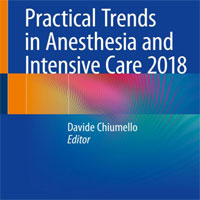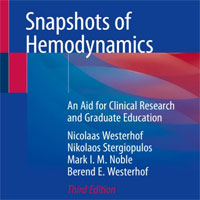Tag: hemodynamics
Ultrasound-based Clinical Profiles for Predicting the Risk of Intradialytic Hypotension in Critically Ill Patients on Intermittent Dialysis
In critically ill patients on intermittent hemodialysis, the absence of hypervolemia as assessed by lung and vena cava ultrasound predisposes to intradialytic hypotension and suggests alternative techniques of hemodialysis... read more
Adaptive Mechanical Ventilation with Automated Minimization of Mechanical Power
Adaptive mechanical ventilation with automated minimization of inspiratory power may lead to more lung-protective ventilator settings when compared with adaptive mechanical ventilation according to Otis' equation. Comparing... read more
Pulmonary Artery Catheters for Adult Patients in ICU
Pulmonary Artery Catheters (PAC) is a diagnostic and haemodynamic monitoring tool but not a therapeutic intervention. Our review concluded that use of a PAC did not alter the mortality, general ICU or hospital LOS, or cost... read more
Practical Trends in Anesthesia and Intensive Care 2018
This book offers an essential guide to managing the most-debated hot topics of practical interest in anesthesia and intensive care. It reviews the state of the art in issues concerning both intensive care medicine and anesthesia,... read more

Using Additional Pressure Control Lines When Connecting a Continuous RRT Device to an ECMO Circuit
The present study suggests that the use of additional tubing can be considered a simple and safe method for pressure control and improvement of filter survival when connecting a continuous renal replacement therapy (CRRT)... read more
Snapshots of Hemodynamics
This new edition reviews recent developments in genetics and molecular biology and new noninvasive measurement techniques that have enabled vast improvements in the measurement and understanding of cardiovascular hemodynamics.... read more

Echocardiographic Assessment of Pulmonary Artery Occlusion Pressure in Ventilated Patients
TEE accurately predicts invasive PAOP ≤ 18 mmHg in ventilated patients. This further increases its diagnostic value in patients with suspected acute lung injury/acute respiratory distress syndrome. During two consecutive... read more
Mobilization Practices for Patients with Burn Injury in Critical Care
Mobilization therapy of patients with burns in the ICU was characterized by a low mobility level during mechanical ventilation with a low functional status at hospital discharge. Of the 74 patients admitted, 66% were placed... read more
Vasoactive Medication and Randomized Clinical Trials
Vasoactive medication is one of the cornerstones in the treatment of critically ill patients in shock. Shock can be defined as a failure of the circulatory system to provide adequate tissue perfusion resulting in cellular... read more
Refractory Septic Shock: Our Pragmatic Approach
Despite timely intervention, there exists a small subgroup of patients with septic shock who develop progressive multi-organ failure. Seemingly refractory to conventional therapy, they exhibit a very high mortality. Such... read more
Cardiovascular Dynamics in Critically Ill Patients
Although widely used among physicians and frequently present in the literature, the words "stable" and "unstable" to describe cardiovascular dynamics in critically ill patients can have different meanings to different people... read more
The Role of Central Venous Oxygen Saturation (ScvO2) as an Indicator of Blood Transfusion in the Critically Ill
Transfusion of red blood cells is an everyday practice in critical care with the primary aim of restoring adequate tissue oxygenation. However, blood transfusion may also be harmful and costly, therefore a so called restrictive... read more
Extubating Ventilated Patients on Vasoactive Infusions is Safe
In a large single centre study, 21% of intubated patients who received infusions of vasoactive infusions while mechanically ventilated were extubated for the first time while still receiving them. Coincident with their earlier... read more
Serum Chloride Levels in Critical Illness – The Hidden Story
Chloride is the principal anion of the extracellular fluid and vital for both serum electroneutrality and acid-base homeostasis. The aim of this review is to investigate the relevance of dyschloremia in the critically... read more
Hemodynamic Monitoring – The Why, When, Which and What
Although the need to properly assess and monitor the hemodynamic status of a critically ill patient appears self-evident, the plethora of information in the published literature over the past two decades has resulted in complexity... read more
Possible Link Between Splanchnic Circulatory Changes and Exhaled CH4
The aim of this study was to explore the possible link between splanchnic circulatory changes and exhaled CH4 in an attempt to recognize intestinal perfusion failure. Methane (CH4) breath test is an established diagnostic... read more
Hemodynamic Impact of Oxygen Desaturation During Tracheal Intubation Among Critically Ill Children With Cyanotic and Noncyanotic Heart Disease
Oxygen desaturation was more commonly observed during tracheal intubation in children with cyanotic versus noncyanotic heart disease. However, hemodynamic tracheal intubation associated event rates were similar. In both groups,... read more
Measuring Cardiac Output at the Bedside
The purpose of this review is to review the importance of cardiac output (CO) or stroke volume (SV) measurement and to discuss the various methods (devices) used in determination of CO. Bedside cardiac output measurement... read more
TPTD Techniques in the Hemodynamically Unstable Patient
Transpulmonary thermodilution (TPTD) devices invasively measure not only cardiac output but also several other hemodynamic variables estimating cardiac preload, cardiac preload, systolic function, the lung oedema and systolic... read more
Venous Doppler and Veno-Cardiac Coupling
Concepts have been clanging around my head since I participated in Philippe Rola's sedulous Hospitalist & Resuscitationist Conference in Montreal. Initially, the abstractions of ventriculo-arterial coupling, Guytonian physiology... read more
Metabolic sepsis resuscitation: the evidence behind Vitamin C
Sepsis resuscitation generally focuses on hemodynamics. Rivers of ink have been spilled writing about oxygen delivery and fluid responsiveness. This is clearly important, but it's possible that our focus on easily... read more
Vasopressors and Inotropes for Shock Syndromes
Vasopressors and inotropes are cornerstones in the management of shock syndromes. Understanding vasopressors' receptor activity and resultant pharmacological response enables clinicians to select the ideal vasopressor(s)... read more









